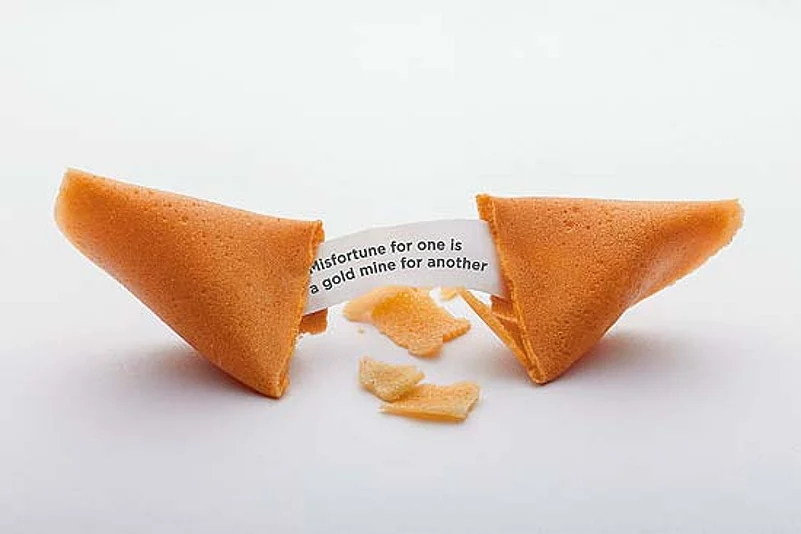“I don’t know if the Chinese Ganeshji will visit our homes this year during festivities,” says an industry veteran based out of Delhi. That’s an incredible statement because for the past 20 years or so, China’s economic might has loomed larger than life over India’s (also impressive) story. China doesn’t have any democracy to speak of, but visitors from India routinely turn all mushy about its infrastructure. Everyone complains bitterly about the quality of Chinese goods swamping our markets, but that didn’t stop Indians from buying it in droves. China’s banks are reeling under debt—a staggering $28 trillion, larger than the US and Germany—but naysayers were told that anything and everything is possible in China.
Well, after a staggering run of 40 years, looks like the Chinese party is over. As the world grapples with the possibilities of a slowdown in China’s factories, those fabled powerhouses of its export-led model, in India many feel this is an opportunity to push for a greater share of global manufacturing in India. The BJP government insists we’re in a better place than in 2008, when the global financial meltdown led to chaos through the financial system. Their logic is simple: if China’s engine of growth is stalling, then the only other engine of growth in the world is India.
While that is true, the nervousness is palpable across boardrooms, showrooms and shopfloors across India. It is yet unclear if India will be able to grab this opportunity. Or be immune to the fallout. As an astute tracker of global money puts it, “The full China story will only be revealed in years to come. But we’ll probably come to see China as the largest credit bubble the world has ever seen. Their asset markets represent ghost cities, and the supporting infrastructure that built them...they are worthless.” The Chinese have devalued the renminbi by 4 per cent to help push falling exports from the mainland.
How will this impact the Indian consumer? From electronic goods to auto parts, readymade clothes, toys, crackers, sparklers to LED and fancy lights, Chinese goods have flooded our homes, lives and even festivities, be it birthday parties or festivals from rakhi to Deepavali. Most experts agree that the currency fluctuations (thanks to a weaker Indian rupee that has depreciated to a larger extent against the dollar than the yuan) may even have a marginal upwards impact on the prices of these Chinese goods.
The fact is Chinese factories are making in China for India, when in fact India must manufacture for India in India, explains Rama Bijapurkar, market research expert. Indian consumers, especially the lower middle class, have been able to access many new products only because of the “China price”. And China prices alone are not the clinching factor behind the success of its exports. “Consumers want a cheaper price and adequate quality for that price,” says Bijapurkar. The items, in short, must meet or exceed a certain “threshold of quality”.
Which is to say, the consumer fascination for Chinese goods will continue—and perhaps deepen over time. Agrees Dr Rajesh Shukla, professor, Institute of Human Development: “The Chinese have a very big market in India, particularly in low-end products. Because of the volatility, these products are now going to cost more, but in the present scenario it will not be possible for the government to take immediate action.”
***
Taking the bigger picture, what has been and continues to be a redeeming factor for the Indian economy is the consistent low price phase of crude oil and commodities like coal, steel and aluminium. It has signalled hope for the Modi government, avowedly committed as it is to more buildings, more bridges and something called ‘smart cities’. Sending out signals of further reforms, the government has not as yet pushed the pause button on disinvestment plans and has, after a failed monsoon session, started making overtures to the Opposition to get the long-awaited gst legislation through Parliament.

Shine on? Chinese Diwali lights on sale in Delhi’s Sadar Bazaar. (Photograph by Sanjay Rawat)
But not everyone is sanguine. Shankar Sharma, chief global trading strategist at First Global, feels there are considerable similarities between the present situation and the Asian crisis. The roots in 1997-98 lay in China depreciating its currency. This led to exports from Asian nations becoming uncompetitive. This widened current account deficits for Asian exporter nations. This led to a run on their currencies, then stockmarkets, then real estate, then the real economy. “The China impact on global corporate profits will be huge, and this is even more worrisome than just a stock or currency fall,” says Sharma.
Actually, a direct offshoot of the economic slowdown in China has been the spurt in exports to India of a range of semi-finished and finished products from steel to capital goods and consumer products, including electronic and white goods. Despite the depreciation of rupee in the wake of yuan devaluation, demand for Chinese goods is expected to remain strong owing to the opaque and competitive pricing of Chinese products. For instance, many power projects are relying on Chinese machinery, which initially help to fill the gap in demand and supply mismatch.
There’s also the fact of a perceptible shift in the Indian small and medium (SME) industries sector from manufacturing to trading. Many of the industries which were earlier relying on local sourcing of semi-finished products and components have over the last many years started relying on imports from China to bring down their costs.
That’s why for many in India who continue to be apprehensive about the impact, the devaluation of the renminbi is a clear conspiracy to grab a bigger share of the global market. Says Prof Biswajit Dhar, global trade expert and professor at JNU, “This is bad news. Even when the Chinese currency was appreciating, exports to India were galloping as it had found much better market access here. And this is not the end, the yuan could depreciate further because China’s decided to let market forces prevail.”
Many experts fear that China will leverage this situation and extract gains, especially in areas where it is strong. And unless India puts its house in order, its exports could be further hit. In any case, unless China opens up for more high value-added products from India, the balance of trade will remain sharply tilted in favour of the second-largest global economy. Last year, China emerged as India’s largest trading partner, ahead of the US and the UAE. From $65 billion worth bilateral trade during last fiscal, this year it is expected to cross $72 billion.
“We feel it is a calculated move by the Chinese to undermine the value of India and Indian products,” says B.C. Bhartia, national president of CAIT, whose Shree Bajrang Sales Pvt Ltd based in Nagpur imports minerals and chemicals, used in auto components and casting units, from China. Electronic goods to capital goods form the bulk of India’s imports from China, while Indian exports to the second largest global economy are mainly raw minerals like copper, ores, mineral fuels besides cotton.
There are obviously two schools of thought here. What should not be overlooked is the fact that China has expanded investment in India. From January-June 2015, China has invested more than $1 billion across a diverse export portfolio. Prof Srikant Kondapalli of the Centre for East Asian Studies, JNU, is dismissive of the conspiracy theory that says this is China’s attempt to integrate into the global monetary system, and to curb flight of capital from the country. China estimates that around $128 billion capital has been invested overseas by illegal avenues.
When comparing labour costs, India currently has an advantage—$100 per month here as against $220 in China. “Many Chinese companies like Foxconn Technology, which manufactures Apple products, has partly shifted operations to India because of the Chinese slowdown and incentives offered in India besides lower labour costs,” says Kondapalli. He expects a boost in Chinese exports to India even as the Asian neighbour helps India set up two major manufacturing hubs in Pune and Ahmedabad to promote the ‘Make In India’ thrust. Of course, while land costs in India are far cheaper than in China, industry watchers point out that land acquisition remains a major challenge for industries.
Even Chinese companies operating in India are sceptical about any immediate impact of the yuan devaluation on Indian operations. Li Nan, vice-president of Meizu Technologies, which has launched mobile phones in India, felt the devaluation was not so strong as to have an impact on operations yet. Network equipment provider Huawei however is happy as its products have high import content, and the devaluation is expected to make their products 5-7 per cent cheaper. This could make a major difference in contracts with ticket rates of $200-250 million.

We got game Chinese construction workers at a Bokharo factory site, Jharkhand. (Photograph by Jitender Gupta)
Indeed, experts also feel that there is a positive side to the devaluation as India could become a good investment destination for China. Says Mrityunjay Kapoor, partner and head of risk consultancy practice at KPMG: “India may end up being a little more attractive for capital that is sitting in China which will now come to India. There is growth happening in India and the fundamentals are quite strong.”
Many industry bigwigs and experts have voiced concerns about an increase in dumping by Chinese companies. Says leading industrialist and Sundaram Clayton group CMD Venu Srinivasan, “If the devaluation was above 10 per cent, then it could have shaken things up...the impact of China is far greater as there is excess capacity of steel, aluminium and tyres which will lead to dumping in India. The churn in China and the Chinese economy and its huge excess capacity should worry us much more.”
Already imports of steel, tyres, auto parts, white goods among other products from China have increased to such an extent that many industries are now running at less than half their capacity. Though the government has increased duty on imports of steel and also levied anti-dumping duty, All India Association of Industries president Vijay G. Kalantri points out, “We are seeing dumping in steel, electronic and white goods. These are having an adverse impact on our industries—the auto industry is running at 60 per cent capacity, the steel industry at 35-40 per cent—all because of dumping and no pick-up in domestic market demand as people are not spending.”
That said, the steel consumption growth in India (7 per cent during April-June 2015) has been in excess of production growth. The expanded demand was entirely met through imports. Due to the twin factors—faster decline of domestic consumption in steel-surplus countries and expansion in domestic consumption in India—surplus from China, Japan and Korea is being dumped in India.
Ditto for tyres. Says Rajiv Budhraja, director-general, Automotive Tyre Manufacturers Association, “The situation is grave. As it is, there is a rising trend of tyre imports from China, and the current yuan devaluation will make their tyres even more cheaper.” Chinese tyres are 30 per cent cheaper than the ones manufactured in India now. What will also aid China here is the fact that while tyre import duty is 10 per cent, China can export tyres to India at just 8.6 per cent as it gets a 14 per cent concession under the Asia Pacific Trade Agreement. In 2013-14, around 41,000 truck tyres were imported every month of which 40 per cent were from China. In 2014-15, this number increased to 65,000 per month with China’s share increasing to 70 per cent.
That worry doesn’t include the stockmarket for now, which has retreated to August 2014 levels in a single day of trading. No, in fact, the worry is whether India will make the most of this windfall in disguise. Andrew Holland, CEO, Ambit Investment Advisors, foresees some volatility in the market but only in bouts. “As I see it, interest rates are going to fall in India. Companies in India are going to benefit from lower material costs as the margins are going to grow. As the earnings grow, the markets are going to realistically reflect that,” says Holland, who has projected that in one year rupee may head to Rs 70/dollar.
Much depends on how the yuan behaves in the next few months and whether it is devalued further. D.K. Joshi, chief economist, crisil, points out again that India has not lost competitiveness to China as the rupee has weakened more than the Chinese currency. “We are better prepared now than in 2013 with good fundamentals, and good forex position, GDP growth, current account deficit and fiscal growth. It’s just that sentiments are playing a bigger role than fundamentals, and this is driving markets down,” he says.
The market dynamics and the next moves of China to bolster its economy may be hard to predict but whether we will make most of this window of opportunity to boost Make in India remains in the hands of policymakers. A reform of government focus could make the difference.
For Make in India to become a reality, there is much that governments—both federal and state—will have to do. They will have to improve the ease of doing business, revive labour-intensive industries like textiles, consumer durables etc which had been the engine of China’s growth. “Where Indian manufacturers play and compete seriously, they do quite well. For example, toiletries and food are all Indian,” says Rama Bijapurkar. Only a foolish man would disregard all the go-for-it advice from the crumbling Chinese fortune cookie.
***
How A Slowing Chinese Economy Will Impact India
China’s made it clear that it will do everything possible to jumpstart slowing growth. India is vulnerable. But opportunity too beckons…
The Big Picture: India is in a better position than in 2013 as forex reserves are robust, deficits are low, and GDP is on a high growth path. But with manufacturing and exports slowing down, India remains vulnerable.
Dumping Fears: With devaluation coupled with excess capacity in China, dumping concerns—in steel, aluminium, tyres and consumers goods—will increase.
Reforms Tack: The BJP government is pooh-poohing fears of an adverse impact, and is using the China crisis to push ahead on reforms like new Goods and Services Tax bill and controversial changes to labour laws.
Currency Fears: A sympathetic devaluation of the rupee is complicating matters; at this stage, RBI governor Raghuram Rajan is quite unlikely to intervene strongly to prop up the Indian currency.
Consumer Goods: Chinese imports to get cheaper, there’s fear of products flooding Indian markets. Already strong in mobile phones, music players, ceiling fans and bulbs, footwear, furniture, games and toys etc.
Make In India: Cheaper project and equipment imports will push manufacturing in India, which still has a cheap labour cost advantage compared to China.
Imports from China
in $ millions (2014-15)
- Rubber 281
- Soap, waxes, polishes 52
- Plastic 1,710
- Silk 200
- Toys 412
- Tools, cutlery 248
Chinese investments: Has been a big investor in India; with a crisis at home, remains to be seen if investments will fructify.
Foxconn is expanding in India, says will invest $1 bn
Meizu the mobile firm finalising plans to make in India.
Alibaba’s Jack Ma has plans to invest in India
Mobile firms Meizu, Xiaomi and Vivo; network providers like Huawei and ZTE; consumer goods firms like Haier, Lenovo stand to gain from devaluation.
Indian companies in China: Could find the going tough in a slowing market.
By Lola Nayar, Arindam Mukherjee and Pragya Singh


























